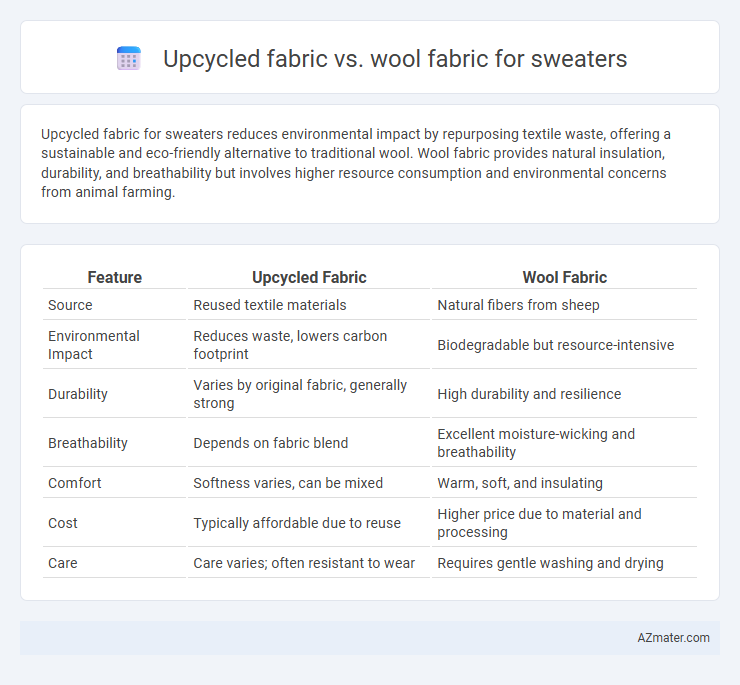Upcycled fabric for sweaters reduces environmental impact by repurposing textile waste, offering a sustainable and eco-friendly alternative to traditional wool. Wool fabric provides natural insulation, durability, and breathability but involves higher resource consumption and environmental concerns from animal farming.
Table of Comparison
| Feature | Upcycled Fabric | Wool Fabric |
|---|---|---|
| Source | Reused textile materials | Natural fibers from sheep |
| Environmental Impact | Reduces waste, lowers carbon footprint | Biodegradable but resource-intensive |
| Durability | Varies by original fabric, generally strong | High durability and resilience |
| Breathability | Depends on fabric blend | Excellent moisture-wicking and breathability |
| Comfort | Softness varies, can be mixed | Warm, soft, and insulating |
| Cost | Typically affordable due to reuse | Higher price due to material and processing |
| Care | Care varies; often resistant to wear | Requires gentle washing and drying |
Introduction: Upcycled Fabric vs Wool Fabric for Sweaters
Upcycled fabric for sweaters offers an eco-friendly alternative by reusing existing textiles, reducing waste and environmental impact. Wool fabric, known for its natural insulation and durability, provides warmth and breathability ideal for cold weather garments. Choosing between upcycled and wool fabric depends on sustainability priorities and performance needs in sweater production.
Defining Upcycled Fabric and Wool Fabric
Upcycled fabric is created by repurposing pre-existing textile materials, reducing waste and minimizing environmental impact through sustainable production methods. Wool fabric, derived from the fleece of sheep, offers natural insulation, breathability, and durability, making it a classic choice for sweaters. Comparing these materials highlights the eco-friendly benefits of upcycled fabric against the traditional, high-performance qualities of wool in sweater manufacturing.
Environmental Impact: Upcycled vs Wool
Upcycled fabric for sweaters significantly reduces textile waste by repurposing existing materials, minimizing landfill burden and lowering resource consumption involved in production. Wool fabric, while biodegradable and renewable, often entails high water usage, methane emissions from sheep, and land degradation due to grazing practices. Choosing upcycled fabric offers a more sustainable option by lowering carbon footprint and conserving natural resources compared to conventional wool production.
Production Processes Compared
Upcycled fabric for sweaters involves repurposing existing textiles, significantly reducing waste and energy consumption during production by minimizing the need for raw material extraction and processing. Wool fabric production requires shearing sheep, cleaning, carding, spinning, and weaving or knitting, which demands higher water usage, energy, and emits more greenhouse gases. The upcycled fabric process has a lower environmental footprint and promotes sustainability through circular economy practices, while wool production relies on animal farming and resource-intensive processing steps.
Durability and Longevity of Sweaters
Upcycled fabric sweaters offer moderate durability but often lack the consistent strength found in wool fabric, which is renowned for its natural resilience and long lifespan. Wool fibers provide excellent elasticity and resistance to wear, maintaining sweater shape and integrity through repeated use and washing. Investing in wool fabric sweaters ensures superior longevity, making them a sustainable choice for lasting wardrobe staples.
Comfort and Wearability Factors
Upcycled fabric sweaters offer enhanced breathability and reduced environmental impact while maintaining softness, making them ideal for eco-conscious wearers seeking comfort. Wool fabric excels in natural insulation, moisture-wicking, and durability, ensuring warmth and long-lasting wearability in varying climates. Both materials provide unique comfort benefits, but wool is typically superior for temperature regulation and resilience.
Style and Design Versatility
Upcycled fabric offers unique patterns and textures, making each sweater a one-of-a-kind statement piece with eco-conscious appeal. Wool fabric provides timeless elegance and natural insulation, supporting classic and refined sweater designs suitable for various occasions. Both materials deliver distinct style versatility, with upcycled fabric leaning toward bold, artistic looks and wool favoring traditional, sophisticated aesthetics.
Cost and Affordability Analysis
Upcycled fabric sweaters typically offer lower production costs due to the reuse of existing materials, making them more affordable and sustainable compared to traditional wool fabric sweaters. Wool fabric, sourced from sheep, incurs higher costs because of animal rearing, harvesting, and processing, leading to premium pricing in the market. Consumers prioritizing budget-friendly options often prefer upcycled sweaters, while those seeking durability and natural insulation might opt for wool despite its higher price point.
Ethical Considerations and Animal Welfare
Upcycled fabric for sweaters significantly reduces textile waste by repurposing existing materials, making it a more sustainable and eco-friendly choice with a lower carbon footprint compared to traditional wool. Wool fabric production often raises ethical concerns due to animal welfare issues, including the treatment of sheep during shearing and the environmental impact of livestock farming. Choosing upcycled fabric supports circular fashion practices and minimizes harm to animals, aligning better with ethical and cruelty-free values.
Choosing the Right Fabric for Your Sweater
Upcycled fabric offers a sustainable option for sweaters by repurposing textile waste, reducing environmental impact while providing unique textures and patterns. Wool fabric, known for its natural insulation, durability, and breathability, ensures warmth and comfort, making it ideal for cold-weather sweaters. Choosing the right fabric depends on your priorities for sustainability, comfort, warmth, and style preferences.

Infographic: Upcycled fabric vs Wool fabric for Sweater
 azmater.com
azmater.com